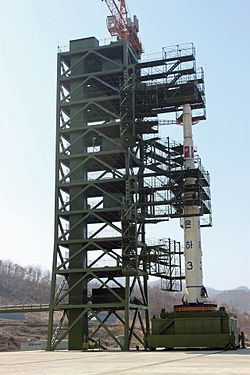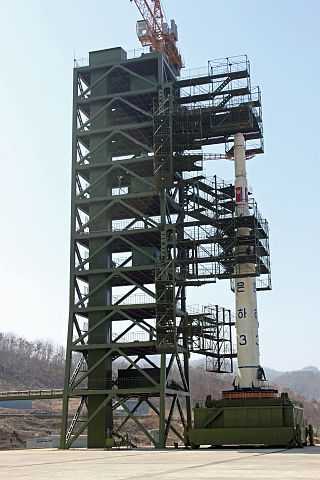Unha
North Korean expendable carrier rocket From Wikipedia, the free encyclopedia
The Unha[a] (Korean: 은하, 銀河, "Galaxy")[6] is a North Korean expendable carrier rocket, which partially utilizes the same delivery system as the Taepodong-2 orbital launch system.[7]
 Unha-3 at launch pad in April 2012 | |
| Function | Expendable carrier rocket |
|---|---|
| Manufacturer | National Aerospace Development Administration |
| Country of origin | North Korea |
| Size | |
| Height | 28–30 metres (92–98 ft)[1] |
| Diameter | 2.4 metres (7 ft 10 in) |
| Mass | 86,750–91,000 kilograms (191,250–200,620 lb) |
| Stages | 3 |
| Capacity | |
| Payload to LEO | |
| Mass | 200 kg (440 lb)[2] (465 x 502 km) |
| Launch history | |
| Status | Active |
| Launch sites | Sohae, Tonghae |
| Total launches | 4 |
| Success(es) | 2 |
| Failure(s) | 2 |
| First flight | 5 April 2009[3] |
| First stage | |
| Height | 15 m (49 ft) |
| Diameter | 2.4 m (7 ft 10 in) |
| Powered by | 4 Nodong 2-1[4][1] |
| Maximum thrust | 1192.8 kN[4][1] |
| Specific impulse | 252 sec[5][1] |
| Burn time | 120 seconds[5][1] |
| Propellant | N2O4/UDMH[4][1] |
| Second stage | |
| Height | 8.8–9.3 m (29–31 ft) |
| Diameter | 1.5 m (4 ft 11 in) |
| Powered by | 4 verniers[4] |
| Maximum thrust | 125 kN[1] |
| Specific impulse | 255 s[5] |
| Burn time | 220 seconds[5][1] |
| Propellant | N2O4/UDMH[4][1] |
| Third stage | |
| Height | 3.7–5.7 m (12–19 ft) |
| Diameter | 1.2–1.25 m (3 ft 11 in – 4 ft 1 in) |
| Powered by | 2 verniers[4][1] |
| Maximum thrust | 35.4 kN[1] |
| Specific impulse | 230 sec[5] |
| Burn time | 245 seconds[5] |
| Propellant | N2O4/UDMH[4] |
History
North Korea's first orbital space launch attempt occurred on 31 August 1998, and was unsuccessful. This launch attempt was performed by a Paektusan-1 rocket, which used a solid motor third stage, a Scud-missile-based second stage, and a Hwasong-7 (Nodong-1) based first stage. Hwasong-7 was a North Korean-developed stage thought to be a scale-up of the old Soviet Scud missile. The Paektusan-1 stood 22.5 metres (74 ft) tall, was 1.8 metres (6 ft) in diameter, and weighed about 21 tonnes.[citation needed]
Vehicle description

The Unha's first stage consists of four clustered Nodong motors, which themselves are enlarged Scud motors. The second stage was initially thought to be based on the SS-N-6, although it, too, is now believed to be based on Scud technology.[4] The third and last stage might be identical to the Iranian Safir's second stage which is propelled by two small gimballed motors.[4][8]
Recent satellite images of the Sohae Satellite Launching Station showing an enlarged launch tower under construction have prompted online speculation that an enlarged version, called "Unha-X", might be under development.[9]
| Unha | |
| Chosŏn'gŭl | 은하 |
|---|---|
| Hancha | |
| Revised Romanization | Eunha |
| McCune–Reischauer | Ŭnha |
Launch history
Summarize
Perspective
On 24 February 2009, North Korea announced that a Unha rocket would be used to launch the Kwangmyŏngsŏng-2 satellite.[10] According to the South Korean government, the launch took place on 5 April[11] from the Tonghae Satellite Launching Ground in Hwadae county.[12] Several countries, including South Korea, the U.S., and Japan, voiced concerns that the launch would violate United Nations Security Council Resolution 1718 which prohibits North Korea from testing ballistic missiles.[13] Russia also announced they urged North Korea to refrain from its planned rocket launch.[14]
On 5 April 2009, the Unha-2 rocket was launched at around 02:30 a.m. UTC (11:30 a.m. local time).[15] The U.S. Northern Command said that the first stage of the rocket fell into the Sea of Japan (East Sea of Korea), while the other rocket stages as well as the payload fell into the Pacific Ocean, and no object entered orbit.[16][17] Later analysis indicated the rocket impacted 2,390 miles (3,850 km) from the launch site, and that the second stage operated normally but the rocket's third stage failed to separate properly.[18] North Korea maintains that the rocket successfully put its payload in orbit.[19]
An Unha-3 rocket was launched at 00:49 a.m. UTC, 12 December 2012.[20] The U.S. Northern Command said that the first stage of the rocket fell into the Yellow Sea, while the debris of the second stage was assessed to have fallen into the Philippine Sea and confirmed that the satellite had entered orbit.[21]
| Designation | Date | Launch Site | Payload | Outcome |
|---|---|---|---|---|
| Unha-2 | 5 April 2009 | Tonghae | Failure | |
| Unha-3 | 13 April 2012 | Sohae | Failure[22] | |
| Unha-3 | 12 December 2012[23][24] | Sohae | Success | |
| Kwangmyŏngsŏng (Unha-3) | 7 February 2016 | Sohae | Success |
See also
Notes
- Also romanized from Korean script as Eunha under South Korea's Revised Romanization.
References
External links
Wikiwand - on
Seamless Wikipedia browsing. On steroids.
